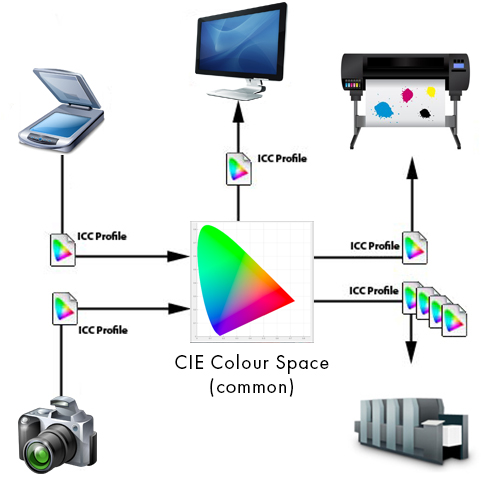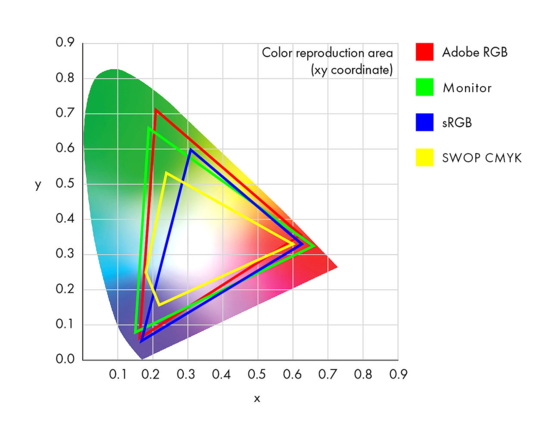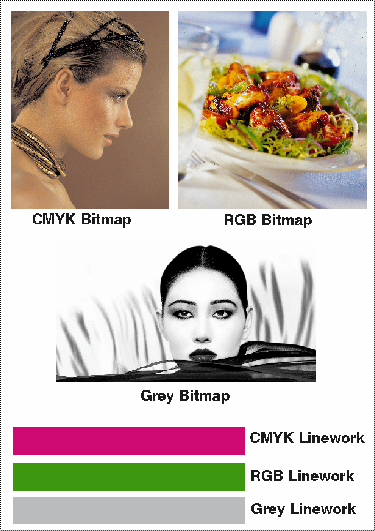16.2 Colour Concept
Colour management features built in to the Shiraz Rosetta RIP is designed to match colours between different input devices such as scanners, digital cameras to the output devices like monitors and printers. In order to carry out this task the colours from one device needs to be translated to another one. This is necessary as each device has a different range of colours or colour spaces.
The actual mechanism for this translation is carried out through the ICC profiles assigned for the input and output. Each ICC profile converts the colour values to and from a device independent space (CIE Lab). This is the intermediate colour space that connects the device dependent colour spaces of input and output devices together. Converting colours always takes two profiles, a source and a destination or input and output. The source profile tells the system what colours the image contains and the destination profile describes how to reproduce those colours on the output device.

All output devices (printers and monitors) have a fixed range of colour and tone that they can reproduce called gamut. The gamut is naturally limited by the most saturated colours the device has to work with, its primaries. You can’t get a more saturated red on a monitor than the red of the monitor’s phosphor. You can’t get a more saturated green on a printer than you can get by combining solid cyan and yellow ink. Output devices also have a finite dynamic range i.e. the range of brightness differences they can reproduce. Beside the primaries, the other two points that define the gamut are the white and black point. The white point of a printer is defined by the paper or media being printed on and the black point is the darkest black reproducible on the printer. Diagram below shows colour gamut of different devices within the human visual range.

Colours present in the source space that are not reproducible in the destination space are called out of gamut colours. The method that these colours are mapped to the nearest colours is called
Rendering Intent.
All the calculations for the ICC transformations are executed by the Colour Management Module (CMM) usually referred to as the engine. The CMM’s main function is to interpolate and calculate
any colour values required.
After that brief introduction to colour and ICC system let us now look at the actual working of the Rosetta colour management system in more details and how the ICC system is utilised within it.
Documents imported to the RIP can have two distinct types of graphical elements within them as outlined below:-
Bitmaps – These are graphical objects that are made of a two dimensional matrix of dots called pixels. Each dot, or pixel, has a defined value that identifies its precise colour, size
and placement within the image. This provides a more natural blend between components, as in a photographic image. Typically these images are captured by scanners or digital cameras. Commercial packages such as Adobe Photoshop or Corel Photo Paint are two of the more popular programs that are used to create and manipulate these files.
Illustrations – These objects are images created according to mathematical formulae that define the shape and colour of their elements such as a line, a circle, etc. This produces sharp delineations between elements and hard transitions between colours. Fonts are also categorised as such objects. Typical packages that are used to create and manipulate these kinds of object are Adobe Illustrator, and CorelDraw.
Both of the objects described above can have one of four colour spaces assigned to them:-
CMYK – This is the usual colour space used for printing, based as it is on inks and dyes. It is a subtractive colour space and uses four colour channels namely Cyan, Magenta, Yellow and Black.
RGB – Most computer screens and scanners use this colour space for output. It relates to transmitted light as the source of colour. This is an additive colour space using three colour channels namely Red, Green and Blue.
Grey – This only uses one colour channel i.e. Black. Typical device used for this are black and white scanners or monochrome monitors.
Lab – This colour model is designed to be device independent and unlike the other colour spaces described above. L*a*b colour, to give it its proper name, consists of a luminance or lightness component (L) and two chromatic components a (green to red) and b (blue to yellow).
Any combination of graphical object and colour spaces can exist within a typical document. e.g. an RGB bitmap, A CMYK line-work and so on. Each of these objects has to be treated differently in order to achieve the correct output result.

The RIP identifies each of these elements automatically while processing and hence can apply the correct settings to each one. An example of a file containing various colour elements is shown above.
The RIP also identifies spot colours, such as Pantone and other user defined ones, within documents while ripping them and if there are associated spot tables set and defined in the RIP then the replacement values would be used in the final output.
